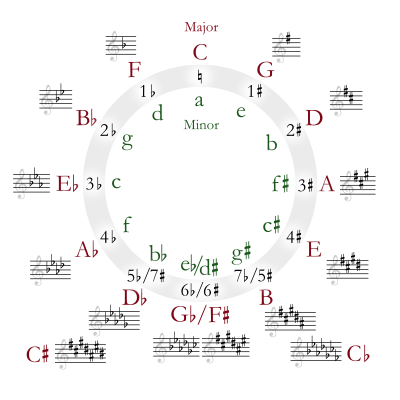 In music theory, the circle of fifths (or circle of fourths) shows the relationships among the twelve tones of the chromatic scale, their corresponding key signatures, and the associated major and minor keys. More specifically, it is a geometrical representation of relationships among the 12 pitch classes of the chromatic scale in pitch class space. Since the term 'fifth' defines an interval or mathematical ratio which is the closest and most consonant non-octave interval, then the circle of fifths is a circle of closely related pitches or key tonalities. Musicians and composers use the circle of fifths to understand and describe those relationships. The circle's design is helpful in composing and harmonizing melodies, building chords, and moving to different keys within a composition.
In music theory, the circle of fifths (or circle of fourths) shows the relationships among the twelve tones of the chromatic scale, their corresponding key signatures, and the associated major and minor keys. More specifically, it is a geometrical representation of relationships among the 12 pitch classes of the chromatic scale in pitch class space. Since the term 'fifth' defines an interval or mathematical ratio which is the closest and most consonant non-octave interval, then the circle of fifths is a circle of closely related pitches or key tonalities. Musicians and composers use the circle of fifths to understand and describe those relationships. The circle's design is helpful in composing and harmonizing melodies, building chords, and moving to different keys within a composition.At the top of the circle, the key of C Major has no sharps or flats. Starting from there and going clockwise by ascending fifths, the key of G has one sharp, the key of D has 2 sharps, and so on. Similarly, going counterclockwise from the top by descending fifths, the key of F has one flat, the key of B♭ has 2 flats, and so on. At the bottom of the circle, the sharp and flat keys overlap, showing pairs of enharmonic key signatures.


Modulation and chord progression
Tonal music often modulates by moving between adjacent scales on the circle of fifths. This is because diatonic scales contain seven pitch classes that are contiguous on the circle of fifths. It follows that diatonic scales a perfect fifth apart share six of their seven notes. Furthermore, the notes not held in common differ by only a semitone. Thus modulation by perfect fifth can be accomplished in an exceptionally smooth fashion. For example, to move from the C major scale F – C – G – D – A – E – B to the G major scale C – G – D – A – E – B – F♯, one need only move the C major scale's "F" to "F♯."
In Western tonal music, one also finds chord progressions between chords whose roots are related by perfect fifth. For instance, root progressions such as D-G-C are common. For this reason, the circle of fifths can often be used to represent "harmonic distance" between chords.
In music theory, a diatonic scale through tones", also known as the heptatonia prima) is a seven note octave-repeating musical scale comprising five whole steps and two half steps for each octave, in which the two half steps are separated from each other by either two or three whole steps. This pattern ensures that, in a diatonic scale spanning more than one octave, all the half steps are maximally separated from each other (i.e. separated by at least two whole steps).
The term diatonic originally referred to the diatonic genus, one of the three genera of the ancient Greeks. In musical set theory, Allen Forte classifies diatonic scales as set form

Tidak ada komentar:
Posting Komentar